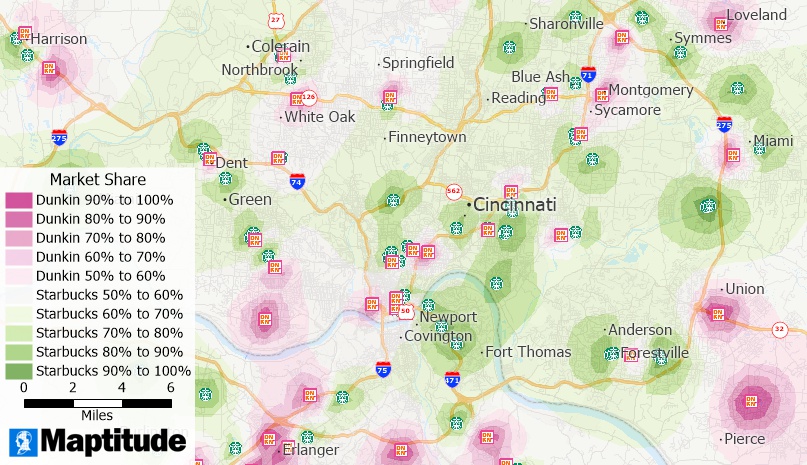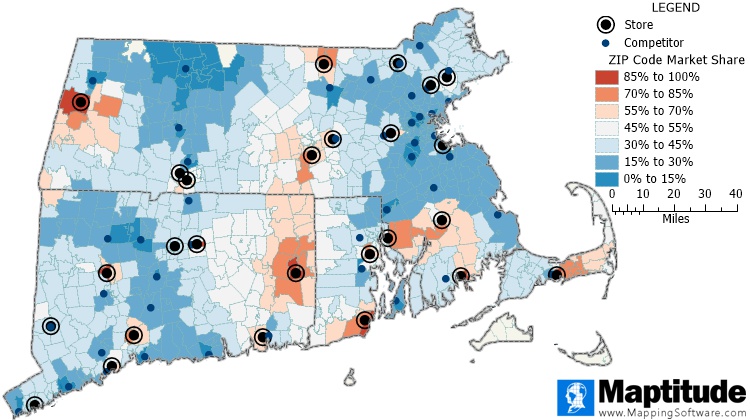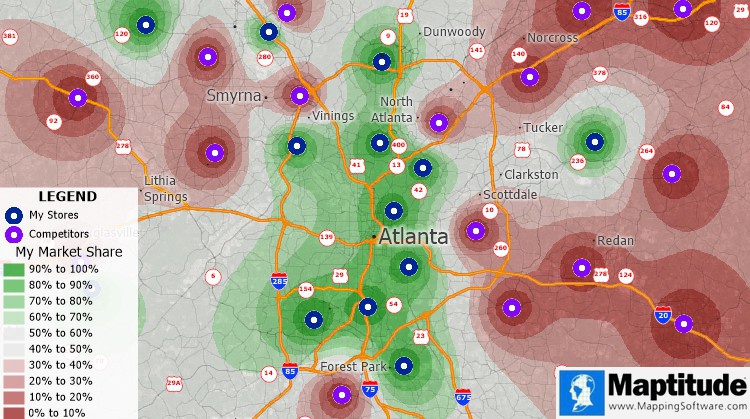

Author:
Stewart Berry
Map
Images: Dan Martin

29 November 2023
Retail trade area analysis is a crucial method for businesses aiming to gain a comprehensive understanding of their customer base. This process involves an examination of various factors, such as the origin and characteristics of potential customers in a specific location. By delving into the demographic profile of these customers, businesses can tailor their strategies to better meet the needs and preferences of their target audience.
Retail trade area analysis offers a number of benefits to businesses, including:

Market Share by ZIP Code - Maptitude Mapping Software
One widely utilized tool in retail trade area analysis is the Huff Model, a methodology designed to map out and quantify retail trade areas. This model aids businesses in visualizing the distribution of their customer base and assessing the level of competition posed by other establishments in the same vicinity.

Huff Model Analysis using Maptitude
The Huff Model can be used to:
To use the Huff Model, businesses need to collect data on the following variables:
Once this data has been collected, it can be used to calibrate the Huff Model. This involves adjusting the parameters of the model to ensure that it accurately predicts the market shares of existing stores.
Once the Huff Model has been calibrated, it can be used to predict the market share of a new store in a given trade area. This information can be used to evaluate potential store locations and to make decisions about marketing and merchandising strategies.
There are a number of ways to get started with retail trade area analysis. One option is to use a commercial software package such as Maptitude Mapping Software. These software packages provide users with all of the tools and data they need to map trade areas, calculate market share, and analyze customer demographics.
Another option is to work with a GIS consultant who specializes in retail trade area analysis. Consultants can help businesses to collect data, calibrate the Huff Model, and interpret the results.
The Market Share Wizard within Maptitude Mapping Software streamlines the complex process of market analysis, providing businesses with valuable insights into their competitive landscape.
To further illustrate the practical application of Maptitude Mapping Software and its Market Share Wizard, a video tutorial has been created. This video serves as a guide, demonstrating how businesses can leverage these tools for effective retail trade area analysis. The tutorial covers essential aspects, shedding light on the intersection of Geographic Information Systems (GIS), business development, and retail analysis.
Retail trade area analysis is a valuable tool for businesses of all sizes. By understanding their customer base and trade area, businesses can make better decisions about where to locate new stores, how to allocate marketing resources, and what products and services to offer.
Retail trade area analysis is a multifaceted process that empowers businesses to make informed decisions by understanding the spatial distribution, demographics, and competition within their customer base. Maptitude Mapping Software emerges as a robust solution, offering businesses the tools they need to navigate and thrive in the intricate landscape of retail analysis.
Learn more about Maptitude to see how you and your team can benefit from mapping software for tetail trade area analysis!
Schedule a Free Personalized Demo

 Check out our G2 Reviews
Check out our G2 Reviews
Home | Products | Contact | Secure Store